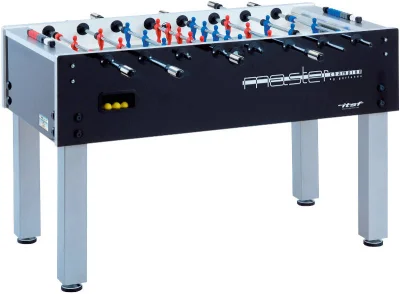Table Football Fun: Why It's Perfect for Family Game Nights
Table Football Fun: Why It's Perfect for Family Game Nights
Blog Article
Table football (Tischkicker), typically known as foosball, is a vibrant and participating game that combinations ability, strategy, and quick reflexes. Whether you are a novice or a professional player, learning desk football needs devotion and the right techniques. Here, we'll discover effective techniques to improve your game and lift your efficiency at any level.
Knowledge the Essentials
Before fishing into sophisticated techniques, it's vital to grasp the fundamentals of desk football. Familiarize your self with the design of the dining table, including the position of the people and the mechanics of the game. Each rod regulates some participants, and knowledge their motion is essential. Positioning your people appropriately can cause successful unpleasant and defensive plays.

Hold and Position
A proper hold and position are critical for get a handle on and maneuverability. Use a calm grasp on the supports, enabling quick movements without dropping control. Stay along with your feet shoulder-width apart for stability, and slim slightly forward to keep balance. That position assists in executing specific shots and fast defensive maneuvers.
Unpleasant Strategies
The Take Shot: That process involves dragging the basketball towards you before striking it. It's among the most effective photos in dining table football. Exercise your time to ensure a fast release following dragging the ball back.
Passing Represents: Successful interaction and timing along with your teammates (if enjoying doubles) can create openings in your opponent's defense. Utilize short, rapid moves to confuse your adversaries and setup for a shot.
Sides and Position: As opposed to firing right at the goal, shoot for sides or make use of the area walls to create unknown angles. That causes it to be tougher for the goalie to block your shots.
Defensive Methods
Preventing: Place your goalie and defenders logically to cover possible shot angles. Keep your defenders shut together to minimize gaps.
Studying Your Opponent: Look closely at your opponent's designs and habits. Expecting their movements may somewhat enhance your defensive capabilities.
Counter-Attacking: If your opponent commits to an offensive perform, capitalize on their overextension. Fast transitions from defense to offense may get them off guard.
Training and Version
Standard practice is required for improvement. Focus on certain abilities during your education sessions, such as for example firing reliability, defensive placing, and moving techniques. Consider enjoying against different opponents to adjust to different playing styles. That diversity can help you develop into a more flexible player.
Intellectual Sport
Desk football isn't more or less bodily skills; emotional resilience plays a key role. Stay focused and created all through matches. If you feel a setback, keep a positive mindset and refocus on your own strategies.

Conclusion
Understanding desk football requires a combination of specialized abilities, proper thinking, and intellectual fortitude. By understanding the fundamentals, building successful offensive and defensive practices, and choosing to regular practice, you can raise your game to new heights. Whether you're playing gently or competitively, applying these methods will not only improve your performance but additionally enhance your enjoyment of this interesting sport. Report this page